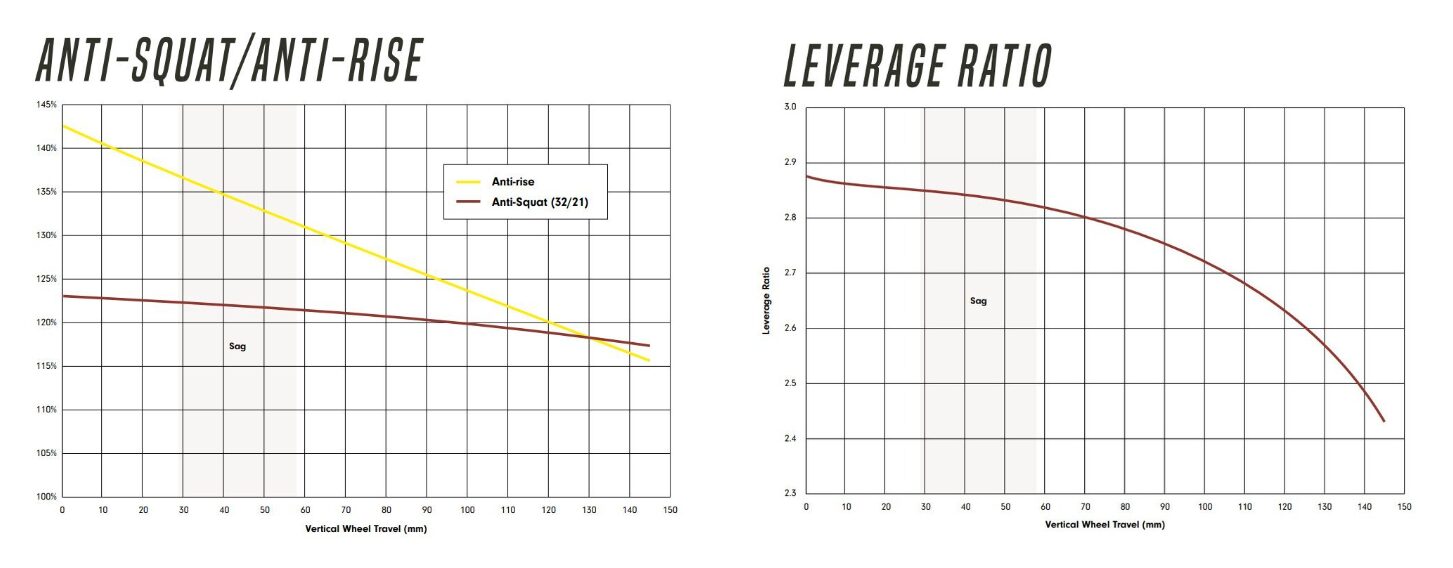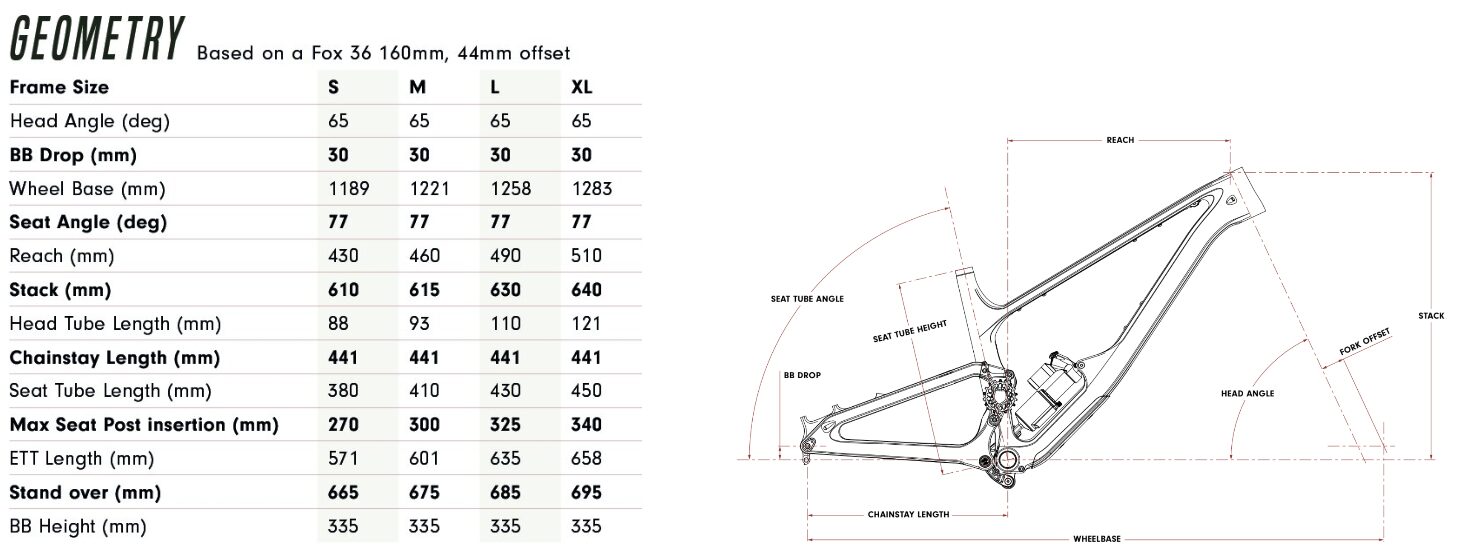Deviate Highlander II
Wheel Size: 29’’ front and rear
Travel: 145 mm rear / 160 mm front
Geometry Highlights:
- Sizes offered: S, M, L, XL
- Headtube angle: 65°
- Reach: 490 mm (size Large)
- Chainstay length: 441 mm
Frame Material: Carbon fiber
Blister’s Measured Weight (Size Large, as built w/ Öhlins TTX2 Air): 32.69 lb / 14.83 kg
Price:
- Highlander II Frameset 2024 Edition: $3,300 USD / $4,500 CAD
- Complete bikes: $7,329 to $10,750 USD / $8,746 to $12,811 CAD
Test Locations: Washington
Reviewers:
- Zack Henderson: 6’, 160 lbs / 183 cm, 72.6 kg
- David Golay: 6’, 170 lbs / 183 cm, 77.1 kg
Test Duration: 2.5 months
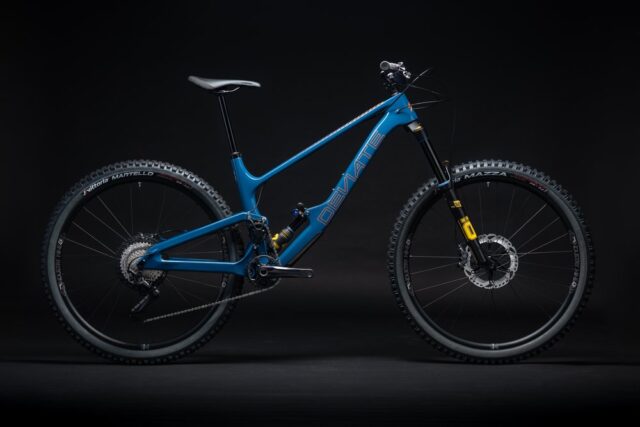
Intro
Deviate was an early adopter of high-pivot suspension designs for Trail / Enduro bikes. Their Highlander 140 was released in 2020, followed by a longer-travel adaptation of the same frame in the Highlander 150, but the Highlander II (apparently there can be more than one) gets an all-new frame.
The Highlander II is positioned as a versatile all-rounder and features some interesting and thoughtful frame details beyond just its high-pivot layout and big idler pulley. Let’s dig into the details to see just what Deviate has brought to the table with the Highlander II.

The Frame
The story of Deviate starts with the Guide — a carbon-framed, high-pivot, Pinion-gearbox-equipped Enduro bike. Released in 2017, it was both an early expression of Deviate’s commitment to high-pivot bikes and a showcase of their willingness to think outside the box. Fast forward to today, and the Highlander II and its burlier stablemate, the Claymore, still share a strong familial resemblance with the Guide.
[For a whole lot more on the Guide and the history of Deviate more generally, check out Ep.177 of our Bikes & Big Ideas podcast with Deviate co-founder Ben Jones.]
Also crafted from carbon fiber, the 145mm-travel Highlander II is built around a 160mm-travel fork. That puts the Highlander II on the aggressive side of the “Trail bike” spectrum, and Deviate’s description of the bike makes its all-rounder intentions pretty clear.

As you’ll likely notice the first time you see it, the Highlander II features a high-pivot suspension design with a link that rotates around the bottom bracket to drive the shock. In addition to lending a rearward axle path (about 23 mm of rearward travel for the Highlander II), high-pivot designs also typically allow for better control over anti-squat and pedal kickback. The Highlander II has fairly high anti-squat stats (about 122% at sag), falling to around 117% at the end of the travel. Its leverage rate is fairly progressive, starting just under 2.9:1 and ending just above 2.4:1, with most of the progression occurring after 70-80 mm of travel.
The Highlander II is a linkage-driven single-pivot bike. That’s worth mentioning because a high-single-pivot layout tends to harbor certain suspension characteristics, most notably high levels of anti-rise, meaning that the suspension tends to compress slightly and feel firmer under braking. The Highlander II’s anti-rise starts just over 140%, ending at just over 115% at bottom-out.
Moving past the eye-catching linkage, Deviate has brought some nice frame details to the Highlander II. All of its pivot bearings have redundant twin-lip wiper seals for added protection, grease ports for easy maintenance, and the idler gets a large (and very nice looking) 18-tooth pulley for reduced drag.
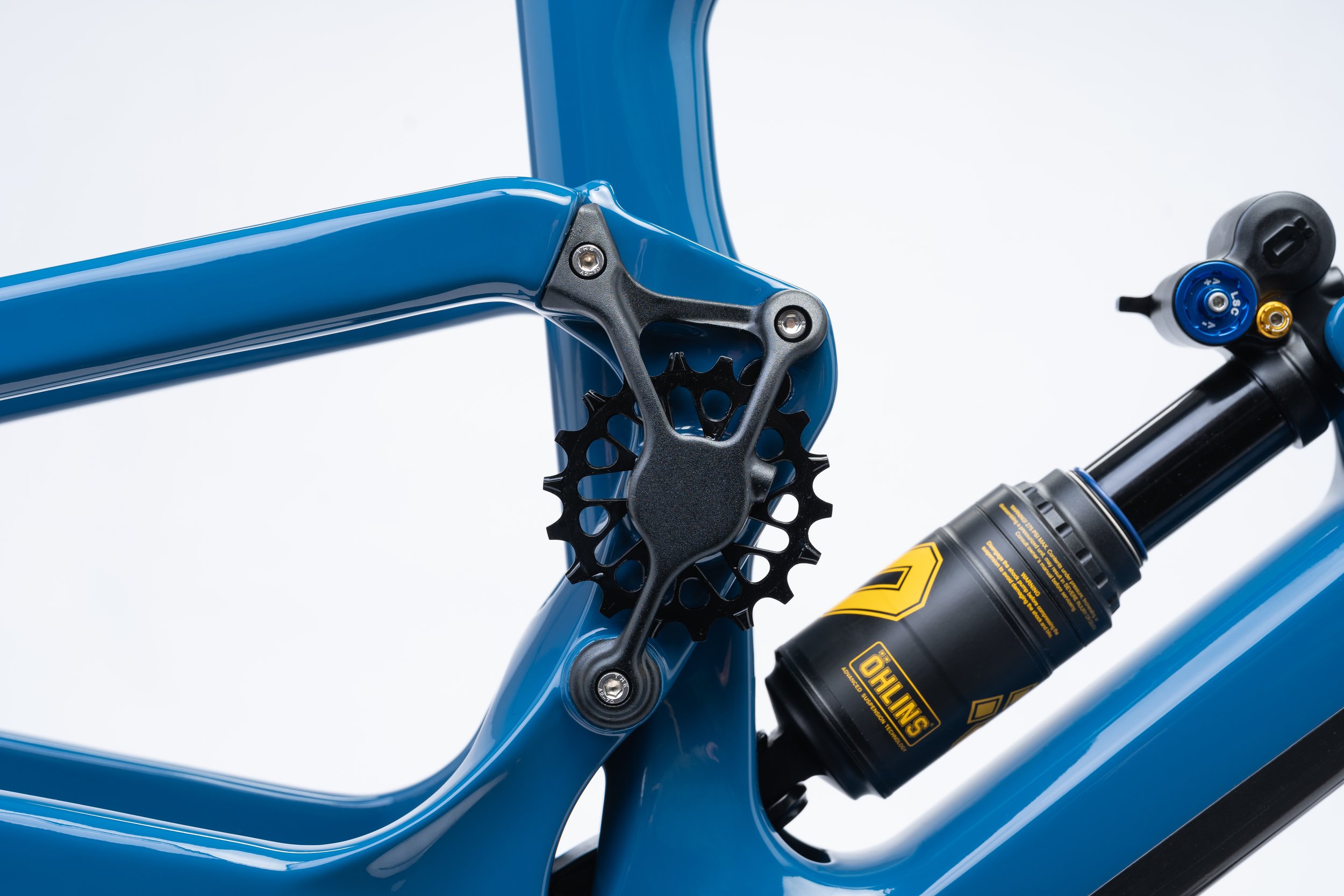

Fit & Geometry
Deviate offers the Highlander II in four sizes, labeled Small, Medium, Large, and XL, and its geometry looks sensible and modern without being over-the-top aggressive.
All four sizes get a 65° headtube angle and 441 mm chainstays. The reach on the size Large is 490 mm, a bit longer than the 480 mm number that seems to be the norm on other Large bikes, and that reach is paired with a 630 mm stack and 635 mm effective top tube length. The reach varies by 30 mm per size — a slightly larger-than-average jump between sizes — but nothing too far outside of normal.
The Highlander II’s seat tube angle sits at 77°, which feels suitably steep for a Trail bike that is likely to see a lot of miles on rolling terrain. The seat tube length is quite short at 430 mm on the size Large, while seat post insertion depth is more than adequate at 325 mm — running a dropper of your preferred length should be no problem on the Highlander II.
The Builds
Deviate offers a lot of flexibility when it comes to builds, with a configurator tool on their website letting you choose from a huge assortment of parts in order to spec a Highlander II to your preferences. Partial builds are available as well. If you’d prefer a pre-configured build, Deviate also offers three standard “Pro” builds, dubbed C, O, and R, in order of escalating price.
The base-level C build is still quite high-end, with DVO suspension, Shimano XT shifting, Industry Nine wheels (w/ flagship Hydra hubs), and Magura MT7 brakes. The O and R builds step up to an Ohlins TTX2 air shock and RXF36 m.2 fork, with the O build getting Shimano XT brakes and drivetrain along with Industry Nine wheels; the top-end R build gets SRAM’s XO Transmission and DT Swiss wheels. All builds also get OneUp’s popular carbon handlebars and Vittoria Mazza tires.
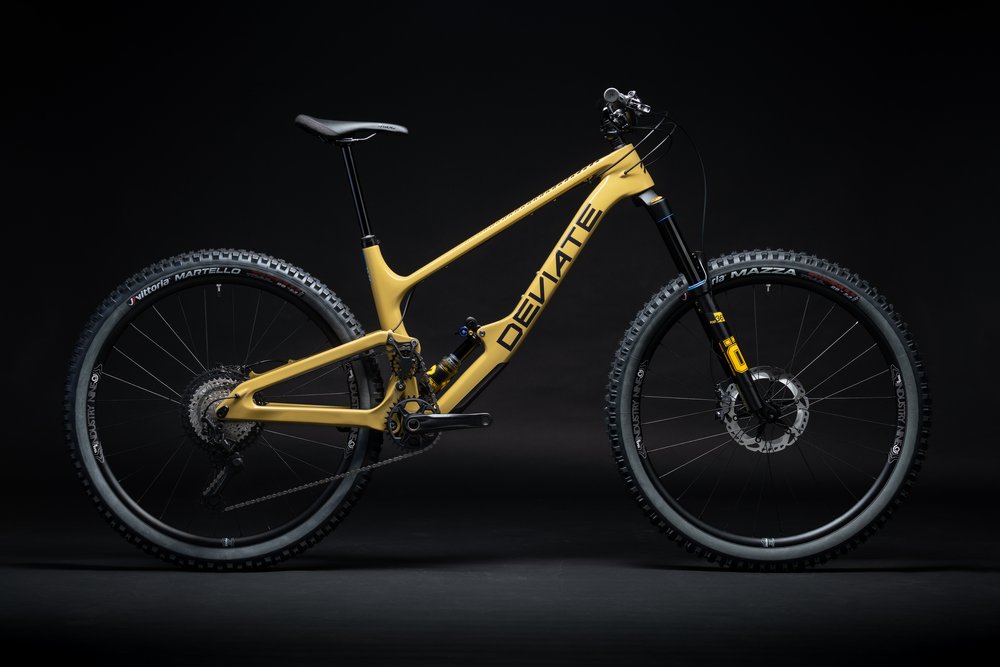
- Drivetrain: Shimano XT
- Brakes: Magura MT7 w/ 203 mm
- rotors
- Fork: DVO Diamond D1 (160 mm)
- Shock: DVO Topaz D1
- Wheels: Industry Nine Trail S Hydra
- Dropper Post: OneUp V2.1 (180, 210, or 240 mm travel selected at checkout)
- Drivetrain: Shimano XT
- Brakes: Shimano XT M8120 w/ 203mm rotors
- Fork: Ohlins RXF36 m.2 (160 mm)
- Shock: Ohlins TTX2 Air
- Wheels: Industry Nine Trail S Hydra
- Dropper Post: OneUp V2.1 (180, 210, or 240 mm travel selected at checkout)
- Drivetrain: SRAM XO Transmission
- Brakes: SRAM Code Ultimate Stealth w/ 200 mm rotors
- Fork: Ohlins RXF36 m.2 (160 mm)
- Shock: Ohlins TTX2 Air
- Wheels: DT Swiss 240 hubs w/ DT Swiss 481 rims
- Dropper Post: OneUp V2.1 (180, 210, or 240 mm travel selected at checkout)
Some Questions / Things We’re Curious About
(1) The Highlander II’s 145 mm of rear travel and 160 mm fork place it on the aggressive end of the ever-nebulous Trail bike category. Does it truly fit into the Trail class in terms of ride quality, or does the rearward axle path help it blur the lines with the Enduro segment?
(2) Some high-pivot bikes we’ve ridden in the past have exhibited some unusual braking characteristics. How do the Highlander II’s higher levels of anti-rise impact performance on the trail?
FULL REVIEW
Zack Henderson (6’, 160 lbs / 183 cm, 72.6 kg): Deviate has been all-in on high-pivot bikes from their founding in 2016 (check out Ep.177 of Bikes & Big Ideas for the whole story), but the layout has mostly been reserved for longer-travel bikes until relatively recently. With 145 mm rear travel, a carbon frame, and a tidy high-single-pivot layout, the Highlander II cuts a sleek profile, but does it have what it takes to compete in the crowded (and mostly non-high-pivot) Trail bike category? We were keen to find out.

Fit & Sizing
Zack: The size Large Highlander II fit me well from the start. The reach is on the longer side of my Goldilocks zone, at 490 mm, but it felt a bit shorter after I put a bunch of spacers under the stem to compensate for the short-ish 630 mm stack, paired with a rather low 20 mm rise bar from OneUp. That also shortened the effective top tube length slightly — which is fairly sizeable at 635 mm — but it feels great for a Trail bike that is likely to see a good bit of seated pedaling time on trails with various levels of incline.
Some companies seem to struggle with the temptation to make high-pivot bikes into descending-first monsters, even shorter-travel ones, so it was nice to see Deviate stick to a moderate 65° head angle. Between that and the not-too-steep 77° seat tube angle, the balance of body position and handling traits certainly helped its case as an all-round Trail bike — but more on that in the sections below. I should also note that the Large Highlander II’s 430 mm seat tube has ample insertion depth, with our test bike running a 210 mm OneUp post and successfully quelling any grumbling I might have otherwise done with a shorter post.
Overall, the Highlander II has some slightly longer-than-average proportions in the reach and effective top tube, but it all comes together nicely (at least for my 6’0’’ / 183 cm height) and makes for a rather comfortable ride both seated and standing.
David Golay (6’, 170 lb / 183 cm, 77.1 kg): I also got along quite well with the fit of the Large Highlander II. Zack already covered the main points, so I won’t rehash too much here, but the main point is that the Large Highlander II fits just a little bigger than average for a size Large Trail bike. As someone who feels on the brink between Large and XL frames with some regularity, that sizing suited me great; as per usual, we’d caution against just blindly going with the same nominal size that you’re used to.
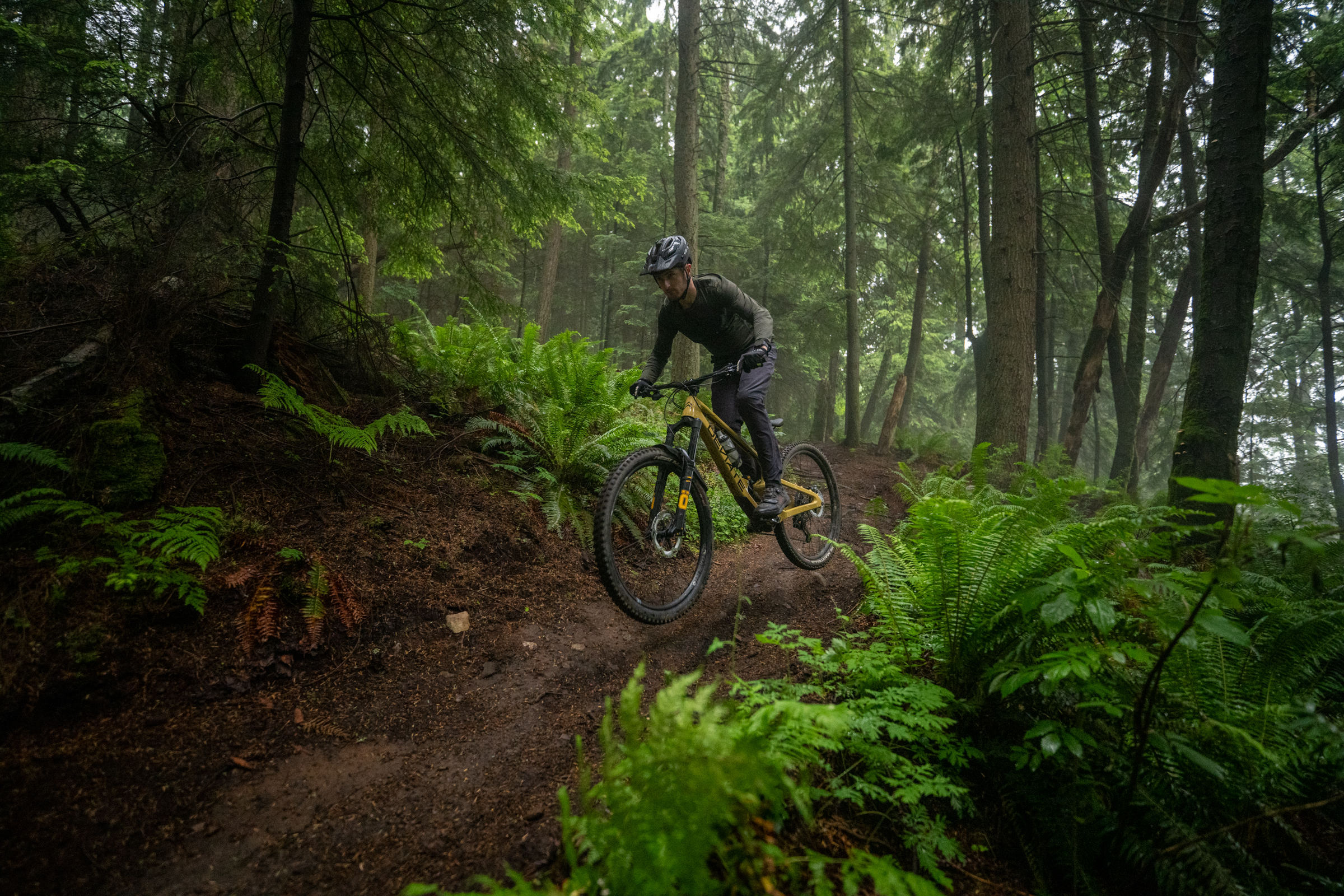
Like Zack, I needed a sizeable block of stem spacers to get the bar as high as I wanted, but Deviate happily left the steerer tube plenty long to accommodate that, and I had a very easy time getting comfortable on the Highlander II.
Climbing
Zack: The prevailing narrative around high-pivot bikes is that they tend to be descending-focused sleds that give up some climbing performance in exchange for high-speed composure. The Deviate Highlander II sure has me fooled, though — never mind the high pivot, the Highlander II is an excellent climber for a longer-travel Trail bike, period.
Deviate uses a larger-than-average 18-tooth idler pulley sandwiched behind a very nice-looking retainer cage, and that big pulley allegedly helps to reduce chain angle and improve efficiency. That may be true, but I attribute most of the climbing traits to the way that the Highlander II’s rather high anti-squat works with the higher damping levels of the Öhlins TTX2 Air shock to keep the suspension motion in check under power. The high pivot also allows the rear wheel to move back and away from obstacles slightly, helping to preserve momentum when you’re really hammering on uphill and flat sections. The result is not only snappy pedaling but an impressive ability to preserve momentum once up to speed — the Highlander II encourages and rewards spirited pedaling efforts.
Remember how I mentioned the lengthy fit? That also proves to be a boon for climbing ability, both on steeper pitches and flatter bits. The Large Highlander II’s cockpit has just enough room to allow me to open up my chest, putting the upper body in an athletic yet roomy position that befits a Trail bike meant for riding all over the mountain, not just down it. All that made the Highlander II an easy choice for some longer days in the saddle where I knew my body would appreciate some extra room to stretch out.
David: By far the biggest thing that stands out to me about the Highlander II’s climbing performance is just how energetic and snappy it feels for a 145mm-travel Trail bike — high-pivot or otherwise. It’s a remarkably efficient-feeling bike that’s not just content to poke its way up the hill at a leisurely pace; it’s surprisingly eager to get after it and climb quickly if you’re so inclined. The climb switch on the Öhlins TTX 2 Air shock isn’t the easiest to reach on the go, given its low-slung position in the frame, but I never felt much need to use it — the Highlander II is remarkably efficient on its own.
The Highlander II’s suspension doesn’t feel especially active under power, exactly, but it does quite well in that regard, given just how snappy and energetic it is. It’s not a bike that’s going to fully iron out every little root and pebble at climbing speeds, but the Highlander II does a solid job of maintaining traction when things get rough and loose. There’s some feedback from the rear wheel to let you know you’re running over things, but the Highlander II’s combination of stellar efficiency and solid traction / compliance is quite impressive.
Descending
Zack: The Highlander II continues to surprise on the way down the hill, bucking some of the trends that are associated with high-pivot bikes while also capitalizing on the design’s strengths. The components also help; for my money, the TTX2 Air rear shock and RXF36 m.2 fork are a top choice for a bike like the Highlander II, with its 145 mm of rear and 160 mm of front travel.
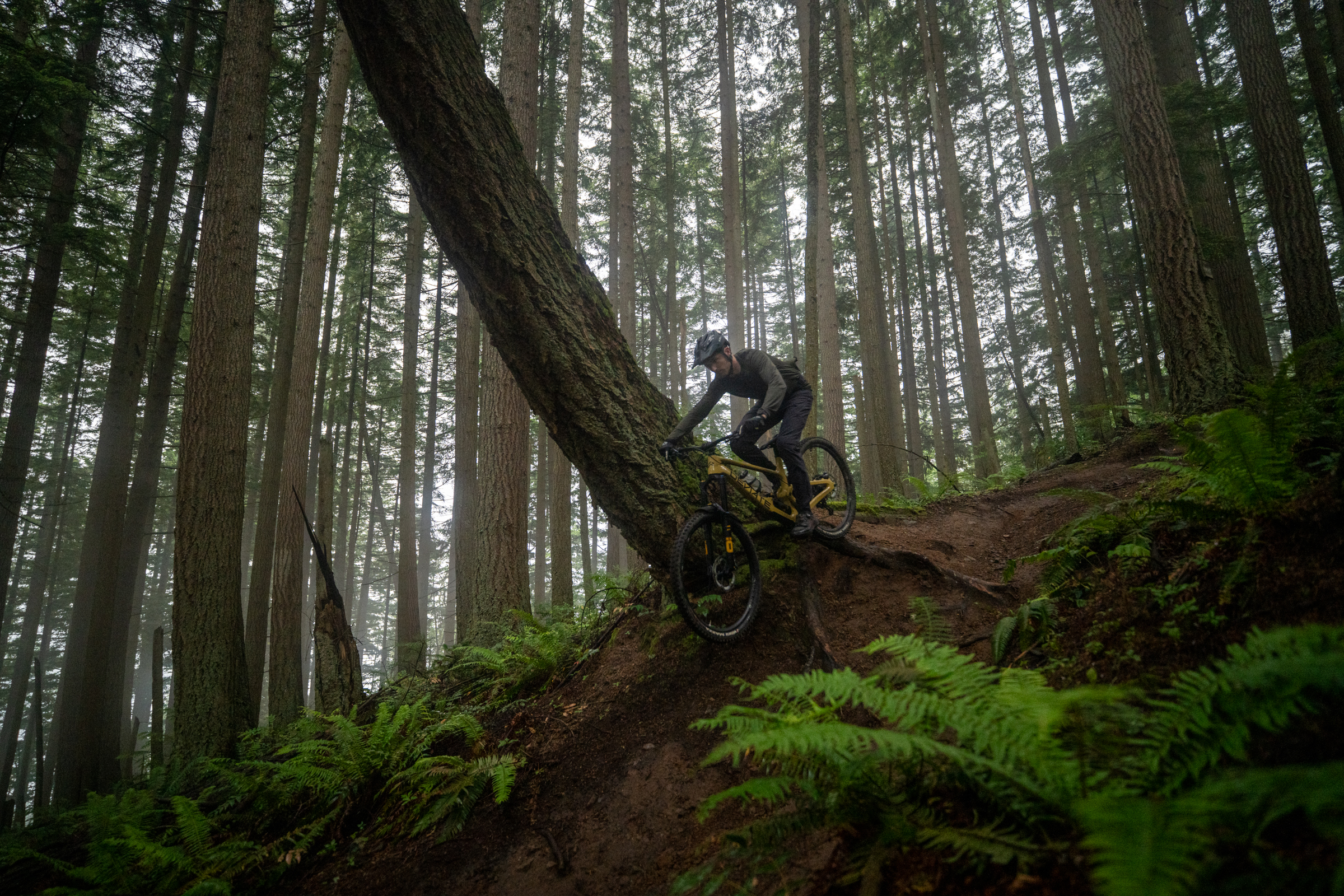
Our Highlander II saw quite a wide range of trails, from rough and blown out to groomed and jumpy. Its fairly progressive high-pivot rear suspension, paired with the very supportive Öhlins suspension, gave a bit more feedback through the pedals and hands than some other suspension choices might. However, it also made for a very dynamic ride that could be confidently chucked into nasty sections of trail while very eagerly leaving the ground for jumps or to be lofted over obstacles. The rear suspension in particular is still plenty sensitive, but I found the higher levels of damping on offer from the Öhlins suspension to nicely complement the surprisingly energetic and snappy handling of the Highlander II and its not-overly-slack geometry.
I found the Highlander II to be so unexpectedly energetic on my first couple of rides that I ended up overshooting several jumps all the way to flat, giving me an opportunity to test the Highlander II’s bottom-out resistance (it passed the test without any big clangs). It honestly took me a ride or two to adjust to the fact that this bike’s combination of sharp handling and momentum-preserving suspension meant that I had to work just a bit less hard to keep the pace high on flatter bits of trail.
The Highlander II is a long-ish bike and feels fairly stable at speed, but I attribute a lot of its playful feeling to its relatively stiff frame, supportive and progressive suspension, and not-overly-slack 65° headtube angle. All of that makes changing directions a bit more intuitive and exciting compared to some of the slacker Enduro-oriented bikes I’ve been spending time on. At the same time, the Highlander II isn’t a bike that feels like it has more than its advertised 145 mm of travel, and it could start to feel a bit undergunned on some particularly rough and steep bits of trail where it couldn’t quite deaden sequential bigger hits like a proper Enduro rig. In other words, in the nebulous and broad world of Trail bikes, the Highlander II is on the burlier end of things, but it’s not necessarily going to be mistaken for an Enduro bike when it comes to trucking through rough stuff.
Let’s be very clear — I think the Highlander II is an excellent descender. But, given the reputation of high-pivot bikes as being straight-line monster trucks, I think it’s important to focus on just how well the Highlander II balances its performance across the mountain to feel intuitive and sharp handling in most situations. Its geometry feels decidedly like a modern all-rounder Trail bike, while its rear suspension packs a ton of capability without erasing the trail or feeling overly ponderous when that surface is smoother.
We talked a bit about it in our initial Flash Review, but our time on high-single-pivot bikes has shown that inherently high anti-rise in many of these designs can create some unpredictable feeling under braking (apart from those with a particularly forward main pivot like the Nicolai Nucleon 16). With high levels of anti-rise, the rear end of the bike has a tendency to squat under braking forces, diving deeper into the travel while the high pivot also effectively lengthens the rear center, which can upset balance. Despite the Highlander II’s high levels of anti-rise, Deviate seems to have managed to avoid the expected drawbacks on the trail.
Under heavy braking, the Highlander II does settle into the rear travel a bit, but it feels more like its “hunkering down” versus diving, with the squatting lending a bit more stability in a straight line. Its chainstays grow by 23 mm throughout the travel, so the rear center is certainly getting longer, but the effect never felt so radical as to upset my balance point. I’ve chalked this up to (1) the more limited amount of travel on tap, (2) the fairly progressive last ⅓ of the travel helping to hold up the bike a bit more, and (3) the high levels of damping on offer from the Öhlins TTX2 Air. Regardless of what it is though, it makes the Highlander II a more confident, intuitive bike.

David: I’m in full agreement with Zack here. The Highlander II really stands out for combining sharp handling and lively-feeling suspension with enough travel and wheelbase to feel relatively composed at higher speeds in rougher terrain. I wouldn’t call it a mini-Enduro bike or anything like that — there many (mostly slightly longer-travel) bikes that are much more planted and confidence-inspiring when really trying to go fast on super steep, rough trails, but those sorts of bikes are generally nowhere close to being as lively and engaging as the Highlander II the rest of the time.
All of that makes the Highlander II one of the most well-rounded, truly do-it-all Trail bikes I’ve been on in a while, at least for folks who’d prefer a bike with suspension performance on the more lively and energetic end of the spectrum, as opposed to being super plush and cushy. The Highlander II can still handle burly trails if ridden with some precision and attention to line choice, but it’s most at home doing a little bit of everything rather than aiming to be a shorter-travel winch-and-plummet sled.
Like Zack, I found the Highlander II’s handling to be quite intuitive, despite past struggles on some other high-single-pivot bikes that felt unsettled by heavy braking. I think the Highlander II’s more moderate geometry (especially the 65° headtube angle) probably goes a long way toward explaining why. On a much longer, slacker bike with a ton of anti-rise, having the front end get even slacker as the rear suspension settles under braking can make the geometry feel pretty extreme, and require some careful weight shifts to manage. On the Highlander II, though, its baseline static geometry is a lot more moderate, so a bit of slackening of the headtube and lengthening of the rear end doesn’t produce a particularly out-there end result, and everything still feels nicely balanced and in proportion. In keeping with that, I’d describe the Highlander II’s preferred body positioning to be generally neutral, and not off to one end of the spectrum or the other (i.e., not super forward nor super upright). It’s just a very intuitive, normal-feeling bike that I had an easy time hopping on and getting comfortable with from the start.
The Build
Zack: We’ll start with the Highlander II’s frame, which is an impressively well-sorted package. It’s great to see double-sealed bearings at the pivots along with grease fittings for a grease gun, even at the idler pulley. The linkage rotates around the bottom bracket on big bearings, but it’s tucked up into the frame and quite hidden away — I didn’t try to disassemble it because it stayed dead-quiet for the test, but servicing could be a bit fiddly when needed, just because of how tightly packaged it is.
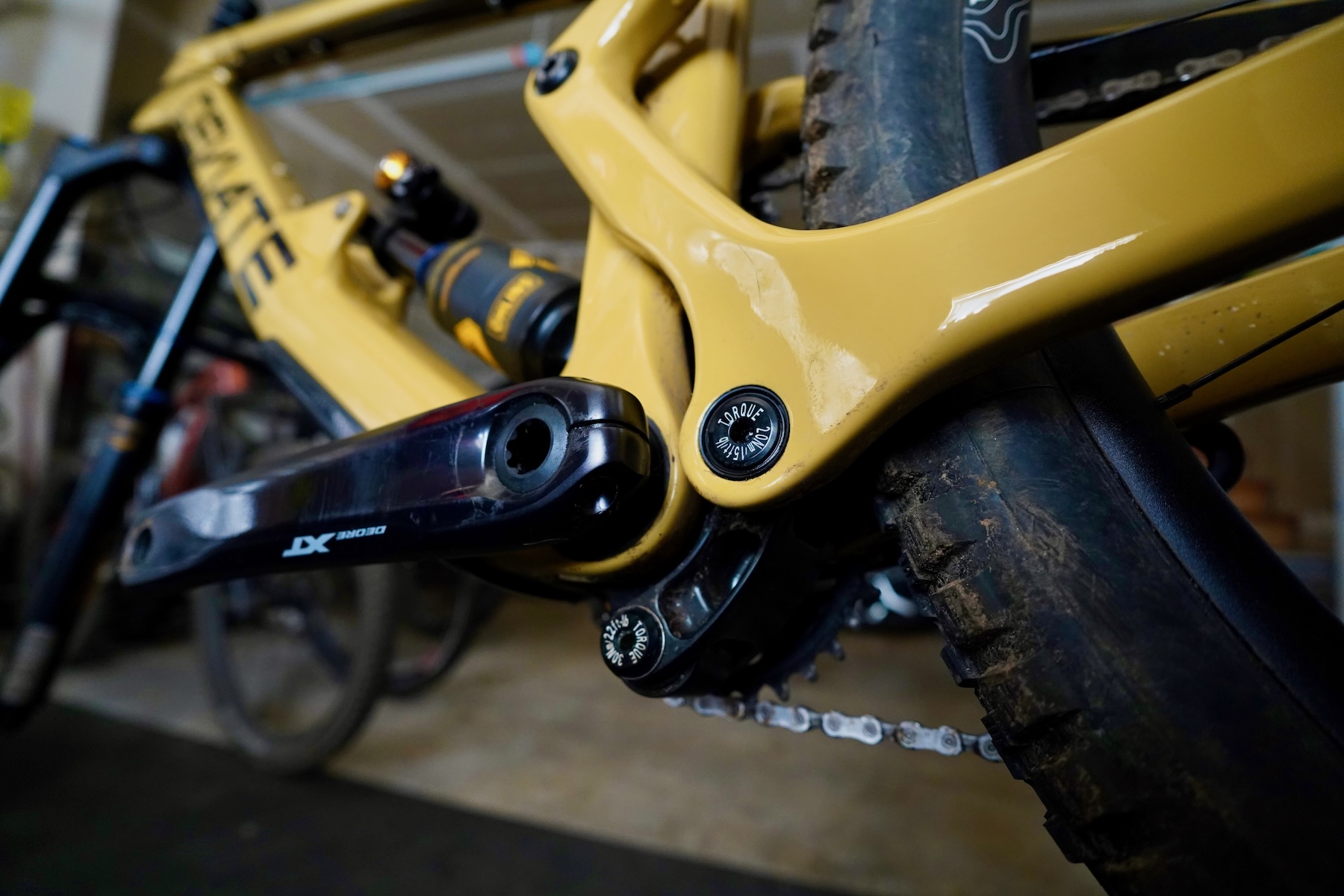
David: I took apart the rear end of the Highlander just to see how everything goes together and how easy it is to work on, and it’s all pretty straightforward. The rocker link axle / bottom bracket shell is a press-fit installation into the frame and requires tapping out with a drift (or Deviate’s tool), but it all came apart smoothly and wasn’t nearly as fussy to work on as I feared it might be, given the tight packaging. Check out Deviate’s instructional video for a more detailed rundown.
Zack: The Highlander II’s paint quality appears very good, and the pivot axles have torque values helpfully etched on them. Nothing came loose, rattled, or squeaked during our time, despite riding through our Northwest spring transition from mud to dust. The only thing I took issue with was the cable routing, which is so close to being fully external, but then disappears into the rear triangle. The channel under the top tube hides the external cables nicely, but I find the choice to create tidy external routing on the front triangle while using internal routing on the rear triangle a bit odd. The cables did slap quite a bit on the sides of the headtube, but frame protection tape and shortening up the housing may mitigate that.
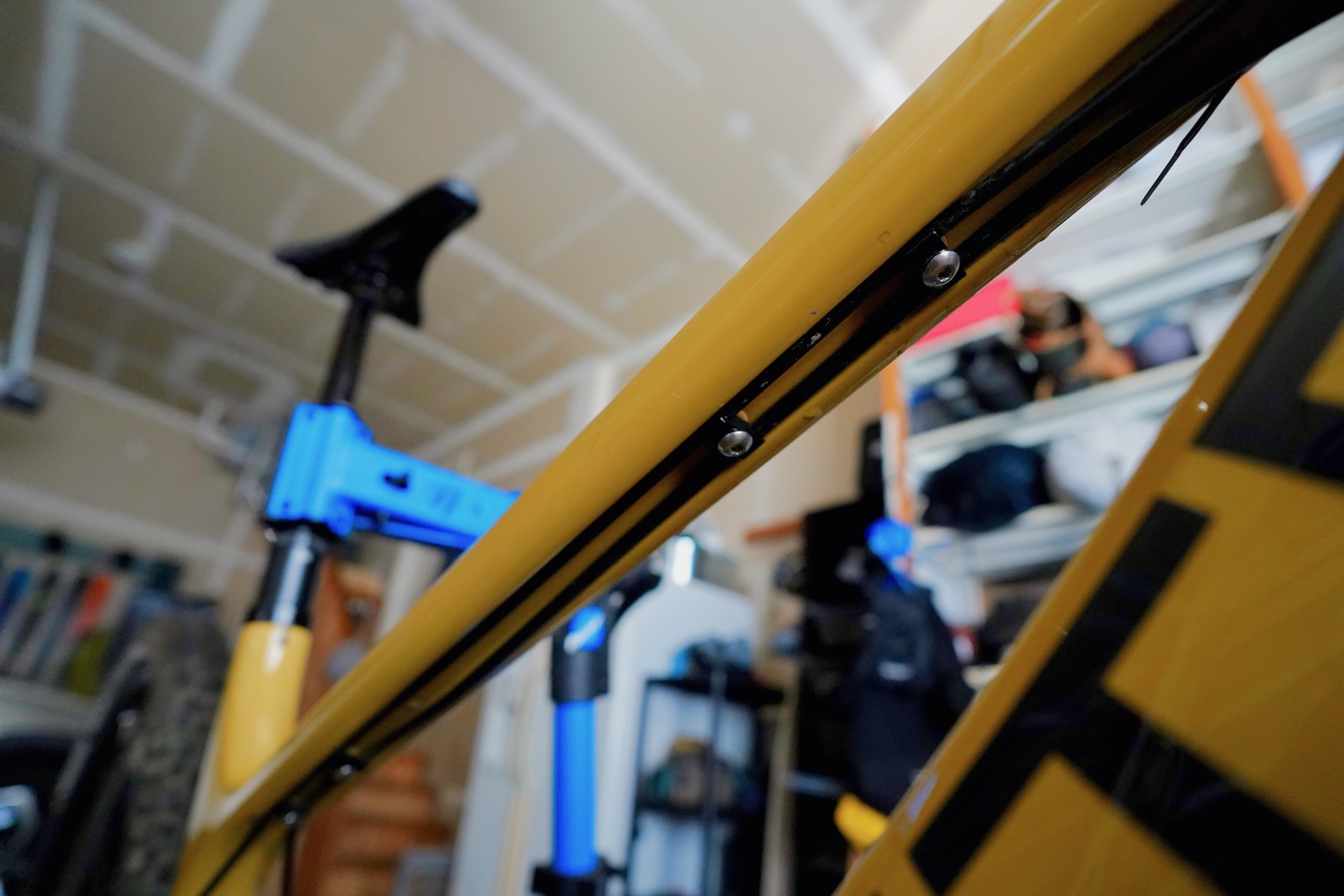
Our Highlander II came with the Pro Build O spec, which features the aforementioned Öhlins suspension, a full Shimano XT drivetrain, and Industry Nine wheels. Were I buying a Highlander II with my own hard-earned cash, it’s likely the build I’d choose, though the $9,000 USD asking price does feel a bit steep, despite a very solid parts package.
I’ve hinted at this through the review, but I was impressed by how the Öhlins suspension complemented the sporty-feeling ride of the Highlander II. The RXF36 m.2 fork could use a bit more sensitivity off the top to compete with it’s bigger brother, the RXF38 m.2, but I’ve grown quite fond of the levels of damping support provided by Öhlins forks, along with their ability to independently adjust two positive air chambers to tailor the air spring curve more precisely. The TTX2 Air shock performed without issue and all but disappeared into the background in concert with the Highlander II’s rear suspension, running fairly quiet and providing plenty of support when pushing the Highlander II toward the limits of its comfort zone.
The Shimano XT drivetrain always wows me with how great it works when brand new, and this one was no exception. Unfortunately, the rear brake self-contaminated slightly at one point, reducing the rear braking power substantially and making a bunch of bad noises. A thorough cleaning and blowtorching of the pads (note: only try this with metal pads) helped, but the issue surfaced a couple of times through the test — likely a case of some leaking caliper seals.
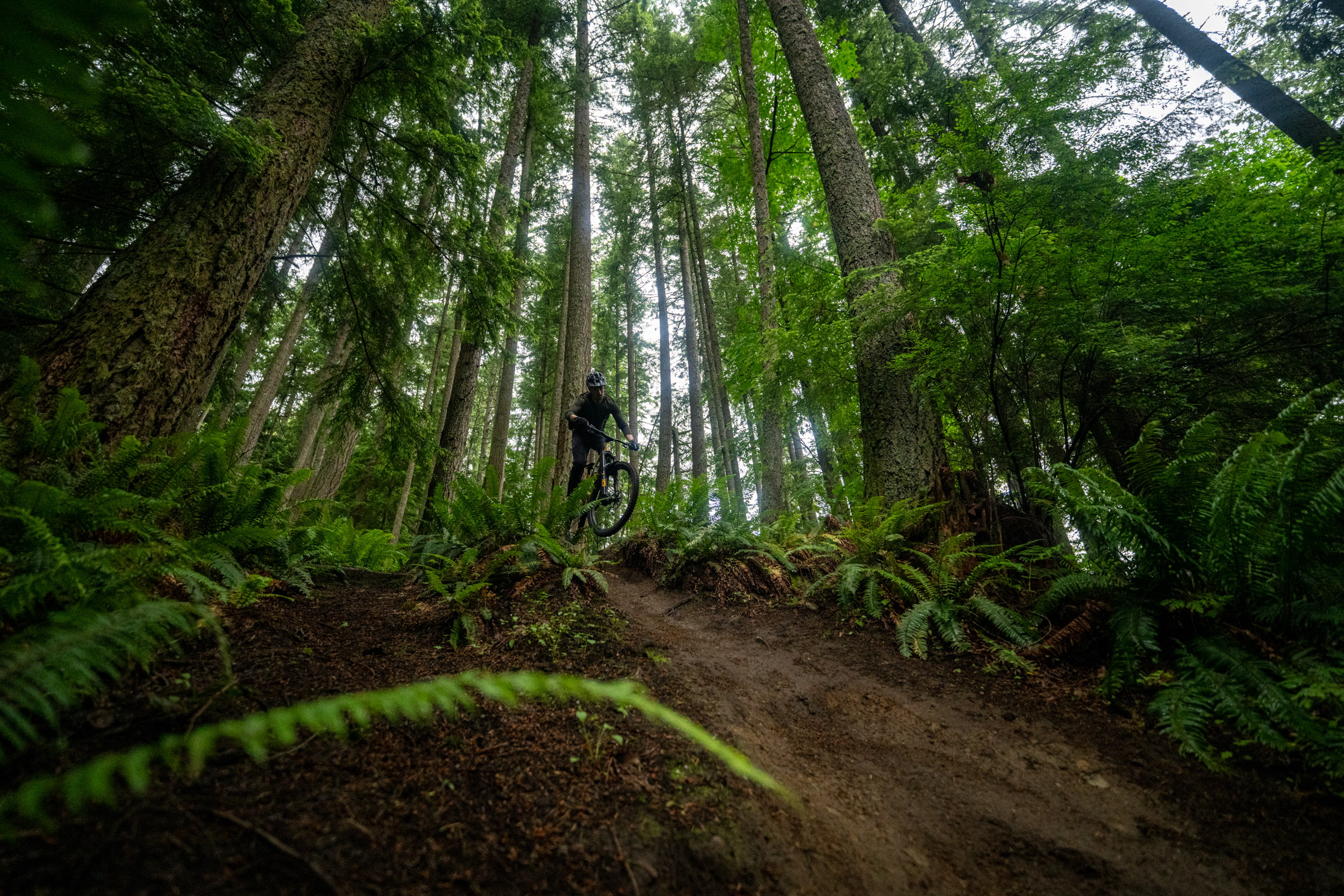
Industry Nine’s Trail S Hydra wheels were dependable but loud. While they stayed true, the Trail S wheels were a bit too flexy for my liking, while also having a narrow rim bed that created a rather round tire profile. Speaking of tires, the Vittoria Martello rear tire and Mazza front would not be my first choice, but they suited the character of the Highlander II fairly well. The casings are a bit thin and prone to rolling, and the rubber isn’t great in the wet, but the Martello rolled fast in dry conditions and the Mazza offered good grip even in looser summer kitty litter. I almost wish Deviate had opted for dual Mazzas, as I found the braking grip of the Martello a bit lacking.
Who’s It For?
Zack: The Deviate Highlander II is, of course, going to appeal to folks who are in the market for something unique, but that’s selling the Highlander II short. Its somewhat uncommon high-pivot layout belies a very versatile, spirited, and just plain fun Trail bike that manages to feel at home on most trails. For folks who find themselves riding all-day epics one day and rough descents the next, the Highlander II stands as a strong candidate for that elusive “quiver of one” aggressive Trail bike that can really capitalize on the abilities of a stronger rider while still being a friendly companion for more intermediate-level folks, too.
David: Yup. The Highlander II is a very — and surprisingly — versatile do-it-all Trail bike that’s perhaps a notch more descending-oriented than most other bikes I’d say similar things about, but it stands out for how well-rounded it is more than anything else. It’s remarkably efficient and snappy on the way up, quite lively and sharp-handling on the way back down, just stable and composed enough to still handle some very burly trails, and feels at home in an impressively wide range of terrain. It’d be an excellent quiver of one for a lot of riders in a lot of different parts of the world.
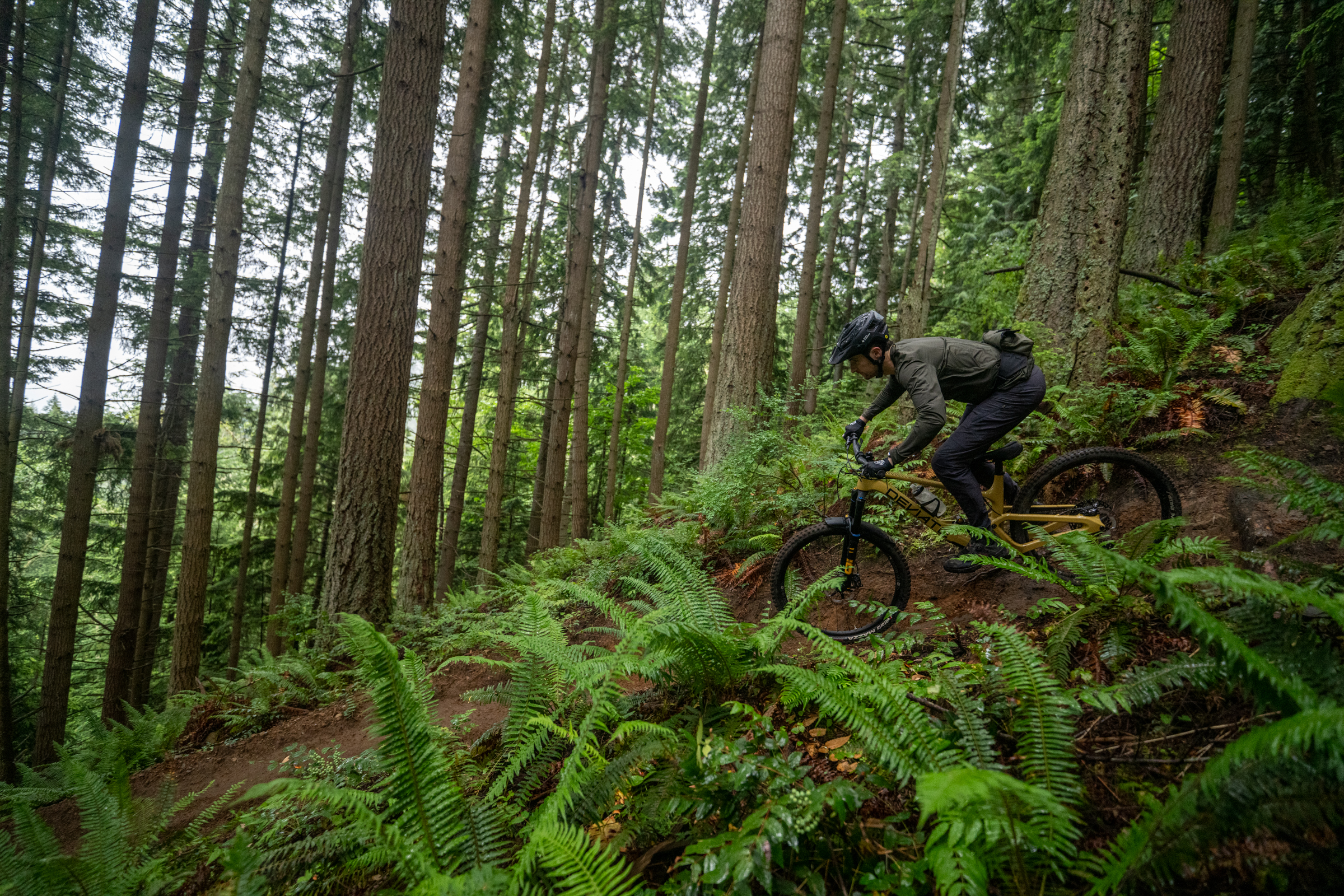
Bottom Line
Zack: I have to admit, I didn’t really know what to expect of the Highlander II, given that it’s still a rare sight here in North America, but I’m ultimately surprised and impressed by what I found. Deviate has imbued the Highlander II with the soul of a Trail bike, not compromising on versatility, but they also leveraged the high-pivot suspension layout to grant some increased capability in rougher terrain, relative to most ~140mm-travel Trail bikes. It’s an especially impressive offering from a smaller brand, and it’s a top contender in the Trail category as a whole for its can-do attitude in just about any scenario.
Deep Dive Comparisons
BLISTER+ members and those who purchase our Digital Access Pass can check out our Deep Dive comparisons linked below. Get our Digital Access Pass to view all our Deep Dives and Flash Reviews, or become a BLISTER+ member today to get access to that and a LOT more, including the best worldwide Outdoor Injury Insurance, exclusive deals and discounts on skis, personalized gear recommendations from us, and much more.
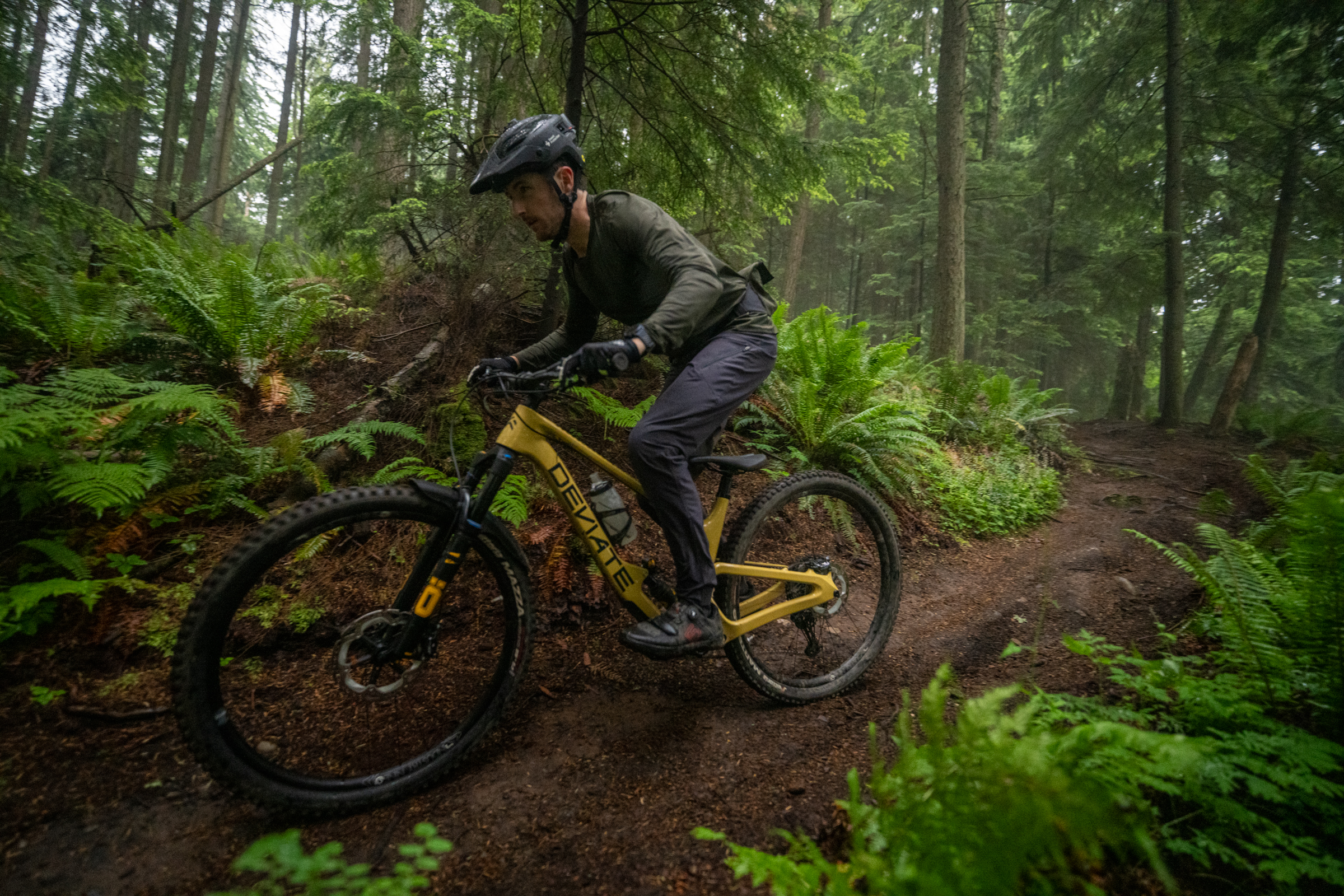
Deep Dive: Deviate Highlander II
We compare the Deviate Highlander II to the Norco Sight, Norco Optic, Kavenz VHP 16, REEB Steezl, Trek Fuel EX, Ibis Ripmo V2S, We Are One Arrival 152, and Santa Cruz Bronson.
Blister’s Flash Reviews and Deep Dives are accessible to those who purchase one of our paid subscriptions
To get our comprehensive Deep Dives and our initial, unfiltered reports on new gear, become a member and receive many other services, deals, and discounts.
If you’re already an active member, please log in.
(If you’re already logged in and a member in good standing and seeing this message in error, please refresh this page in your browser.)

